
The cusk isn’t going to win any piscine beauty contests. It’s no colorful clownfish, sleek tuna, mighty sailfish, or even a silvery sardine.
It looks like a cross between a catfish and an eel. Big flattish head. Little barbell on its chin. A single dorsal fin and a single long anal fin. A fish in a plain brown wrapper — smooth skin with tiny scales, brownish or grayish. Even its name, cusk, has kind of a harshness to it.
By the time Jocelyn Runnebaum sees them, cusk are looking decidedly the worse for wear — their stomachs are protruding from their mouths, eyes are bulging out, skin is bubbled, bellies are bloated. All thanks to an express elevator ride from ocean bottom to surface in a lobster trap where they had inadvertently taken refuge. The trauma is caused when the air in their swim bladder expands as the pressure decreases. It’s kind of a fish version of the bends.
Cusk, Brosme brosme, is the only species in its genus. It is one species commonly caught as bycatch, or non-target species, in deeper waters in Maine’s lobster fishery. At the same time, the fish is not common and not that well understood. It is listed as a Species of Concern by the National Marine Fisheries Service, and is under NMFS status review for listing under the Endangered Species Act.
